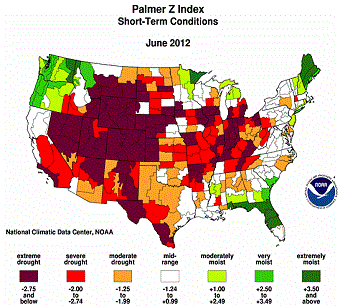The Dust Bowl of 2012: Drought Covers Majority Of U.S.
 This year’s drought ranks as one of the top 10 worst U.S. droughts for the last century. With more than half the country (54 percent) experiencing drought conditions, it’s the single worst drought since the 1950s.
This year’s drought ranks as one of the top 10 worst U.S. droughts for the last century. With more than half the country (54 percent) experiencing drought conditions, it’s the single worst drought since the 1950s.It is hot all over. NOAA said in its June “State of the Climate Global Analysis”:
This is the second month in a row that the global land temperature was the warmest on record for that month.
While it has been hotter than the 1930s in many places in this country, the drought hasn’t been quite as bad as the worst of the original Dust Bowl. But if we don’t act soon to slash greenhouse gas emissions, we are on our way to far worse as climate change fuels more frequent and more extreme droughts across the U.S. (see “We’re Already Topping Dust Bowl Temps — Imagine What’ll Happen If We Fail To Stop 10°F Warming”).
Climate Progress has documented how unrestrained fossil fuel pollution is leading to worsening droughts. Texas’ severe drought of the past memory was made 20 times more likely from global warming, as one study explained. The Nature article last year, “The Next Dust Bowl,” explained, “warming causes greater evaporation and, once the ground is dry, the Sun’s energy goes into baking the soil.”
Climatologist Jonathan Overpeck at Arizona University told the AP:
This is what global warming looks like at the regional or personal level. The extra heat increases the odds of worse heat waves, droughts, storms and wildfire. This is certainly what I and many other climate scientists have been warning about.
This drought is hitting farmers hard — and ranchers, too. As Reuters put it:
Ravaged by fires, Western ranchers face “scary” summer
… recent wildfires in states such as Idaho, Montana, Nevada, Utah and Wyoming have displaced thousands of cows from federal rangelands which may not be fit for grazing for years. Where range has not been destroyed, drought has lessened forage.
“We’re going to run out of grass. It’s shaping up to be scary,” University of Idaho Extension Agent Rauhn Panting said.
The next to be hit is the American consumer.The Agriculture Department has declared the largest federal disaster zone in its history for 26 states, as corn and grain crops dry up, particularly in the midwest where 63 percent of the midwest has moderate to extreme drought. Corn production shrunk 7 percent in the last week, according to a Reuters poll: “What began the season as a potentially record corn crop as farmers planted the biggest area since 1937, may now be the smallest in at least five years.”
Consumers will feel the drought’s burden through rising food prices:
“For sure, the full effect of this drought will not be until 2013. It’ll be 2013 when we see it and its in the whole supermarket,” Richard Volpe, an economist with the USDA’s Economic Research Service said. “But if the price of corn shoots up, we’d see this effect within about two to three months. That doesn’t mean we’ll see a complete jump into food prices. It’s just that we should start to see the effects.”
Michael Swanson, agricultural economist at the largest commercial agriculture lender, said:
“It might be a $50 billion event for the economy as it blends into everything over the next four quarters.”
You can return to the main Market News page, or press the Back button on your browser.

